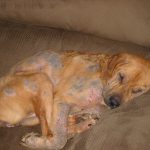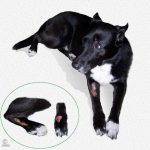Why Is My Dog or Cat Losing Its Hair?
Ron Hines DVM PhD
This is a list of the most common causes of hair loss in dogs & cats. Read about the ones you suspect:








Hair loss is one of the most common reasons dogs and cats visit veterinarians like me. There are a great many reasons for hair loss that your veterinarian will be considering. I’m going to go over the more common ones we see and explain how veterinarians might go about deciding which one is causing your dog or cat’s problem.
When your pet with a hair loss problem visits your veterinarian these are some of the questions that will be asked and observations that will be made:
1) What is your pet’s age? Young pets often lose their hair for different reasons than older ones.
2) What breed is your pet? Certain breeds are prone to specific causes of hair loss.
3) How long has the problem been going on and has it occurred before?
4) If the problem occurred before, how was it diagnosed and treated the last time? Was that treatment effective?
5) Is it a single patch or area that is affected or is it a generalized skin problem?
6) Is the hair loss only on the trunk of the body itself or on the face or limbs?
7) Is the hair missing or is it broken or is it chewed off short?
8) Is the area itchy to your pet?
9) Is the hairless area raw and inflamed?
10) Are the areas dry and crusty?
11) Are the areas a particular shape?
12) What other pets do you have? Are any of them also affected?
13) What do you feed your pet?
14) What changes have occurred in your pet’s environment or life recently?
15) Are you also itching?
16) Do the webs of your pet’s feet itch? Is the hair there discolored?
17) Does your pet also scoot and lick its rear?
18) Are fleas or flea dirt present? Have fleas been seen at home?
19) What do you bathe your pet in and how often?
20) Is yours an emotional, nervous or easily frightened pet?
What Are The Most Common Causes Of Hair Loss Veterinarians Encounter?
Flea-associated Dermatitis
Fleas are the most common cause of hair loss, skin irritation and scratching in all temperate and tropical climates of the world. Even a single flea on your pet can cause hair loss – particularly in dogs and cats with under-shod jaws or flat faces that have trouble catching them. The damage the fleas do depends on how sensitive your dogs or cat is to flea saliva. When many fleas are the problem the parasite’s telltale waste is quite easy for you or your veterinarian to find. But when only a flea or two are the problem that evidence can be very difficult to find. This is particularly true on dark-haired pets. I will often comb them while they stand on a white sheet to improve the chances of my finding “flea dirt”.
One give-away of a flea problem is the typical distribution of the hair loss and skin inflammation. For reasons unknown, fleas prefer the area just anterior and above the base of the pet’s tail. A brittle, broken hair coat in that area – with a characteristic musty (seborrheic) odor and/or the presence of pepper-like granules that stain rust-colored when dampened on a wet paper towel are sure signs of flea involvement. Anal sac impactions are the only other less common but possible cause of that sort of hair loss distribution. Read about that here.
In some pets, the presence of segments of the most common tapeworm of dogs and cats surrounding the animal’s anus, on its stools or hair coat is the only confirming evidence of fleas in your pet’s environment. Read about tapeworms in dogs and cats here. The most common tapeworm of dogs and cats, Dipylidium requires fleas to move from animal to animal.
In some cases, the bite of a single flea will set off intense itching of the entire body. In dogs, it is most often the webs between the pet’s toes that itch the most. In white and light colored dogs, the fur in those areas becomes honey colored to brown. Those pets have developed a flea-bite allergy. Read more about that here. Eventually, bacteria and yeast take advantage of the situation. The best treatment is to apply advanced topical flea-control medications – I prefer the topical ones like Advantage®, Frontline®, and Revolution®. If you are dissatisfied with those, there are oral alternatives. Read about them here. But I believe that topicals are a safer option when they do the trick. The cheap flea powders and other products you see in supermarket and pet store isles don’t end flea problems. Fleas are far and away the most common reasons why your dog or cat could be losing its hair.
Read more about flea problems in dogs and cats and what to do about them here
Canine And Feline Atopy (Allergies)
When you have allergies, you sniffle and sneeze. When your dog has allergies, it itches and scratches. Cats can go either way – itchy skin or respiratory problems.
Although fleas and their saliva are almost always included in the list of things that bother allergic pets, anything you yourself might become allergic to in the environment is something your dog or cat has the potential to become allergic to as well. Scratching causes the pet’s hair to break off or fall out faster than it can be replaced. Once the protective outer barriers of the skin are broken, other opportunists like Malassezia yeast/fungus or staph bacteria take up residence. But they are never the primary cause of a hair loss or inflamed skin problem in an otherwise healthy dog or cat.
Unfortunately, antihistamines which are moderately effective in humans are much less so in dogs and cats. There is no full cure for pets that are allergic to things they breathe or most of the things they come in contact with. If you move to a new area of the country, your pet will likely be better for a while. But eventually, it will become allergic to new things.
Canine and Feline Atopy is an inherited disease. It occurs in families of dogs and cats. If your pet has the problem, one or both of it parents likely did too. Pets are generally a year or so old when the scratching and hair loss begins. The younger in life the problem begins, the more severe the problem often becomes as time goes by.
Treatments for secondary bacterial and fungal infections and inflammation will make the problem more bearable – but they will not cure it when allergies are the underlying cause. Those helpful treatments include antihistamines, soothing topical shampoos used weekly or biweekly, soothing anti-inflammatory topical ointments, bathing agents that keep bacteria and yeast in check and tranquilizers that lessen itching. Some owners even resort to mechanical cone collars to prevent chewing.
I am not a believer in the accuracy of blood-sample-based allergy testing. Traditional skin testing – as a human allergist would perform on you – is somewhat more accurate. But avoiding the many things that these tests tell you your pet might be allergic to is rarely possible and the helpfulness of injectable and oral antigen desensitization formulas leave much to be desired.
Two newer medications are available that do effectively block most cases of allergic itching. Read about Cytopoint® here and Apoquel® here. I am not a big fan of Atopica® which does stop itching in most dogs – but at a high cost to their long-term health. It has too many potential and serious side effects. My current choice of the three is Zoetis’ Cytopoint®.
When all else fails, judicious use of cortisone-like products are our last defense. All cortisones (corticosteroids), like prednisone, have potentially serious side effects. They are safest when they are applied to the skin as a mist, spray or lotion rather than taken internally. When they must be given orally, we try to give them at the lowest possible dose – and as infrequently as possible. I do not recommend that they be given by injection for itching. The only exception might be in pets that are so difficult to give oral medications to that no other option exists. Corticosteroids are available in transdermal gels (skin patch). Since they are compounded by individual pharmacies, their effectiveness is likely to vary. But as an alternative to injections, they are worth a try – particularly budesonide and beclomethasone. They, too, are not without risk.
Read more about allergies in dogs and catshere
Hot Spots (Pyotraumatic Dermatitis)
This is a particular problem in long-coated, thick-haired breeds of dogs with rich oily coats. Often these pets are about 2 years old or older when the problem first occurs. When I practiced in San Antonio, Texas and Sarasota, Florida, they were often northern dogs, which had recently moved to our southern climates. However, that could have just been because there were a significant number of northern retirees moving there at the time. Golden Retrievers, Cocker Spaniels, Spitz, Samoyed, Chows, Akitas, and G. Pyrenees topped the list. It is a rarer problem in cats. When it does occur in cats, it is often during or after major emotional stress or related to the eosinophilic granuloma complex. Read about that problem here. Pets with hot spots develop Intense itching in one or two isolated area of the trunk of the body. These areas become inflamed, raw and oozy with serum within a matter of hours. Pets frantically chew and lick at these areas. Some people come to me thinking that an insect bite started the problem. But I have never found an identifiable insect bite in a hot spot area. I believe that the nerves providing sensation in the area are somehow falsely stimulated. If the dog is muzzled or restrained during the initial period, the problem passes in 24-72 hours. If not, when the area is painful enough, the pet will cease biting at the area. Hot spots may reoccur every 4-8 months or never again. Many veterinarians treat hot spots with a topical astringent/cortisone lotion and often with an injection of anti-inflammatory drug as well. Some might also give a long-lasting antibiotic injection – perhaps Convenia®. An Elizabethan collar for restraint is usually a necessity as well. Because the pets get better after almost any form of veterinary treatment, I am not certain that any of those products are the reason that the problem goes away. For reasons unknown, the nerve pain that initiates the problem stops as suddenly as it starts.
Acral Lick Granulomas
Acral lick skin lesions are somewhat like chronic hot spots. They are stubborn and difficult to cure. These raw, hairless areas most commonly occur on a dog’s lower front or rear legs. As with hot spots, I believe that neurological pain plays a part in initiating these lesions. They are always moist, rarely scabbed and appear to cause considerably more consternation to dog owners than to the dog itself. They are rarely dangerous in themselves. But because they open a window into the body for infection, the areas need long-term protection from licking canine tongues.
Read more about acral lick granulomas here.
Demodectic Mange
The first form, demodectic mange, is a disease of young dogs or dogs that have become immunosuppressed later in life. This parasite, which lives in the hair follicles of your dog’s skin, is commonly present in low numbers in healthy dogs – perhaps all dogs. The mites are transmitted from mother dogs to their puppies during nursing, probably within three days of birth. The mites only become a problem when they begin to multiply out of control. The parasite’s ability to excessively proliferate is thought to be due to genetic defects in some dog’s immune systems. For undetermined reasons, immune cells that would normally attack these parasites appear to ignore them.
Demodectic mange runs in certain bloodlines and breeds of dogs – particularly those with wrinkly skin. It causes hair loss but no itching. The involved areas are very subject to secondary bacterial infections. Those infections can cause itching. Until recently, veterinarians treated this form of mange with amitraz (Mitaban®) dips or with ivermectin (ivermectin can be very toxic to cats and some collie and herding-type dogs). More recently, it was found that some of the oral flea control medications for dogs will cure demodex disease as well. Read about those products here. Small (dime-size) demodectic mange lesions often disappear without treatment or with no more than topical spot treatments as the pet’s own immune system learns to recognize and kill the parasites.
Read more about demodectic mange here
Sarcoptic Mange
Sarcoptic mange is due to a more transmissible mite that burrows through the layers of your pet’s skin causing intense itching. This parasite passes from pet to pet through direct contact and contaminated bedding. It will attack humans as well (where it earned the name “The Seven-Year Itch”). Sarcoptic mange is easily cured in your pet once it is recognized as the culprit behind your dog or cat’s itching and hair loss problem. Ivermectin given orally or by injection and selamectin (Revolution®) will usually eliminate sarcoptic mange. As with demodectic mites, ivermectin-like products must be used with caution (if at all) in cats and herding-type dogs. Some of the newer oral flea-control products will also cure sarcoptic mange. One is Simparica®. Read more about that group of products here.
Sarcoptic mange mites – even when present – can be quite hard for your veterinarian to find and identify in skin examinations (scrapings) when your dog or cat has been itching for a long time. One occasional clue to their presence is knowing that the dog or cat’s owner has been itching as well. Giving anti-itch corticosteroids often makes both sarcoptic and demodectic mange cases worse. So many vets will cover their bases and add a mange-killing medication to their itch/hair loss treatment plan when they are suspicious of this parasite’s involvement – even when no mites were found.
Read about sarcoptic mange here
Ringworm
Ringworm is a fungus – not a worm. It is transmitted by pet-to-pet contact or through some object – such as grooming clippers and combs. It is not itchy. The area(s) devoid of hair are often circular or oval. The hairs in these areas are broken off – due to the fungus growing in and weakening the hair shafts. These spot(s) are often located on a leg, ear or the face. The individual hair shafts often glow in the dark when the pet is placed under an ultraviolet light source (Woods lamp). Ringworm-infected skin areas may spontaneously disappear (especially in cats). But these animals often remains a silent carrier of the fungus. Ringworm is usually treated with oral fluconozole or itraconazole. Topical iodine preparations inhibit the fungus’ growth, but take much longer to be effective. Griseofulvin is also effective, but it is no longer a frequently used medication because the lengthy time it must be given to obtain results. Ringworm can spread to you – so wash your hands well after handling pets with ringworm. Preferably, wear gloves. Do not let your children play with or fondle pets with this problem or objects the pet has contact with. Over the years, I have spotted ringworm lesions on the forearms of many cat-owning clients while their cat looked perfectly normal. But in many of those cases, glowing hairs could be seen on the cat when examined under UV light.
Read more about ringworm here
Nervousness Or Stress/Boredom Induced Dermatitis
High-strung breeds and pets tend to react to itchy skin problems more forcefully – damaging their skin and hair coat more in the process. So do pets with too much unoccupied time on their hands. This is a more common problem in dogs than in cats and more common when both members of a couple work and the pet must be left unattended.
Older, obese and lame pets also tend to over-groom more. Once those habits ares established, they are hard to cure. Quick fix treatments include topical bitters mists (which seldom work). Relieve boredom while you are away in any positive way possible. Some pets do better in a fenced yard while their owners are away. Others do better in air conditioning or with the TV left on. Some owners resort to anti-obsessive/compulsive drugs such as clomipramine (Clomacalm®) Making the licked area(s) on your pet inaccessible with taping and protective coverings or cones always work well. But when the protection is removed, the problem generally returns.
When this problem occurs in cats, stress between multiple cats is commonly the underlying cause. A cat pheromone product called Feliway sometimes seems to help in these situations (However, a 2017 study did not find Feliway®-type products very helpful in combating stress in cat shelter situations). Similar products are available for dogs. Their effectiveness is also problematic. When compulsive licking and hair coat chewing occurs in non-stressed cats and dogs, another internal, underlying health problem is usually present.
Read about anxiety-related problems in dogs here
Food Allergies
Food allergies are over-diagnosed in dogs and cats. Food intolerance that cause digestive disturbances are more common. Pets with true food allergies often itch all over, all the time. Pets that are allergic to food or food-treat ingredients have immune system cells (mast cells) in their skin that release histamine when the pets eat certain proteins. The best way to diagnose this problem is to place your cat or dog on a 60 – 90 day hypoallergenic trial diet and feed only treats that are hypoallergenic. These special diets either contain ingredients that the pet has never eaten before; or they contain protein molecules that have been made so small that the pet’s immune system no longer recognizes them. These modified protein diets can be fed indefinitely. Diets prepared from novel (new) proteins and carbohydrate sources (like duck and potato) may help for 6 months to a year. But eventually, the dog or cat will likely become allergic to them too and a new formula will have to be tried.
Non-skin Internal Health Issues
Your pet’s hair coat is also a mirror of the health of its internal organs. So, diseases of almost any organ or gland can cause poor hair coat quality, broken hairs and a thinner than normal hair coat. So can nutritional deprivation. So can too frequent litters. The only two internal diseases I know of that have the potential to actually cause itching (pruritus) are autoimmune diseases and liver problems. Read about liver problems here. Examination of your pet’s blood-test results are the way veterinarians usually discover these underlying root causes. Read how pet laboratory tests are grouped to detect liver disease here. Read about normal test result values here
Heavy Shedders
Some dogs leave hair around the house all year long instead of having one or two normal big sheds a year. If you are faced with that problem in your dog you might solve it by manipulating your dog’s light cycles. Most dogs today have “free running clocks”. That is, their melatonin cycles are off because they are not exposed to the natural light of the seasons. You might try some of the light manipulations I suggested that in my article about Alopecia X, (the section on Altering Your Dog’s Day-Night Cycles). Much less is known about the effects of light on your house cat – but few if any animals do not keep internal track of the season when they are exposed to natural light.
These are the most common reasons why your dog or cat might be losing its hair
You are on the Vetspace animal health website
Visiting the products that you see displayed on this website help pay the cost of keeping these articles on the Internet.






